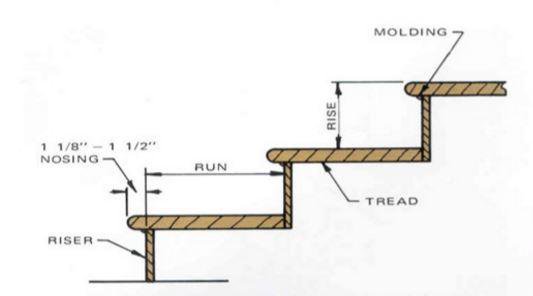Steps and Stairs
Steps have three or less risers and stairs have four or more.
The rise is the vertical height, or space, between each step, also known as the riser height.
The run is the tread depth (or horizontal depth).
A tread is the part of the step that you step on. The part of the tread that protrudes over the riser is called the nose and typically is an inch or less.
formula
R = Riser T = Tread
2R + T = 24" (or 24 to 25 inches) R + T = 17" (or 17 to 17½ inches) R * T = 70" (or 70 to 75 inches)
The general rule is 7-11 (a 7 inch rise and 11 inch run) or no more than 7 3/4 inches for the riser and a minimum of 10 inches for the tread.
Use the tool called a speed square to help you in building steps or stairs.
The overall rise and run of the steps is determined by measuring the space where the staircase is to fit. Take the space height (inches), from floor to where the top destination will be and divide by 7. Round the decimal down and use that number to determine the number of treads you will need.
The Rise plus the Run should equal approximately 17 1/2 inches. Stairs or steps tend to have steps at or near 7 inches and treads at or near 10 inches deep.
From another source: 7 1/2" is considered the perfect step. Take the overall rise divide by 7 1/2 to find out how many steps. Round decimals down to the nearest hole number.
There is one less tread than riser because the upper floor is the final step.
Total number of steps less 1 because the upper floor is the top step is the total number we have to chop up or divide our total run by.
considerations
Don't bump your head! Headroom minimum is almost always 6' 8" anywhere along the length of the stairway.
